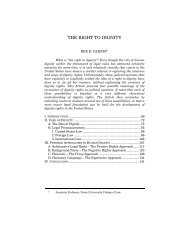A Right to Media? Lorie M. Graham - Columbia Law School
A Right to Media? Lorie M. Graham - Columbia Law School
A Right to Media? Lorie M. Graham - Columbia Law School
Create successful ePaper yourself
Turn your PDF publications into a flip-book with our unique Google optimized e-Paper software.
2010] A RIGHT TO MEDIA? 479<br />
public policies that limit the ability of tribal governments <strong>to</strong><br />
determine their respective telecommunications destinies. 192 In this<br />
digital age, increased access <strong>to</strong> Internet connections could aid in the<br />
promotion of media rights.<br />
Additionally, the lack of clarity regarding tribal control over<br />
telecommunications on tribal lands has been a barrier <strong>to</strong> increasing<br />
telecommunication access by Native Americans. 193 J.D. Williams, the<br />
general manager of the Cheyenne River Sioux Tribe Telephone<br />
Authority (CRSTTA) in South Dakota, says that “a]ccess <strong>to</strong><br />
broadband media depends on who controls the system,” and “if the<br />
local media company is tribally owned they tend <strong>to</strong> look first at the<br />
telecommunication services the people need most . . . and then ask<br />
how <strong>to</strong> deliver these services in a rural setting.” 194 He compares this<br />
approach with that of an outside company whose decisions are based<br />
primarily on revenue growth.<br />
CRSTTA was founded in 1977 with a loan from the Rural<br />
Electrification Authority and now provides telephone and television<br />
services for four communities with an emphasis on local needs. 195<br />
Such examples reinforce the argument that telecommunications for<br />
indigenous communities is most efficiently analyzed through the lens<br />
of sovereignty, much like land rights and mineral rights.<br />
Unfortunately, not all tribes are as favorably situated <strong>to</strong> create<br />
community programming in the way that the Cheyenne River Sioux<br />
Tribe has, particularly from a funding standpoint.<br />
Organizations such as Native American Public<br />
Telecommunications (NAPT) have created funding programs <strong>to</strong> help<br />
finance new Native American media projects in a broad array of<br />
formats. 196 The Corporation for Public Broadcasting has similarly<br />
noted as a priority the need <strong>to</strong> fund indigenous media, since listeners<br />
“depend on these stations <strong>to</strong> cover national and local news, deal with<br />
community issues, and create links across geographic and tribal<br />
192. HearUsNow.org, Communities: Native American,<br />
http://www.hearusnow.org/other/8/nativeamerican (last visited Feb. 5, 2010).<br />
193. Bissell, supra note 190, at 141.<br />
194. Ken Freed, NATV Challenging <strong>Media</strong> Frontiers, <strong>Media</strong> Visions<br />
Journal (1996), http://www.media-visions.com/itv-natv.html.<br />
195. Id.<br />
196. Native American Public Telecommunications, Structure,<br />
http://www.nativetelecom.org/structure.html (last visited Feb. 5, 2010).















